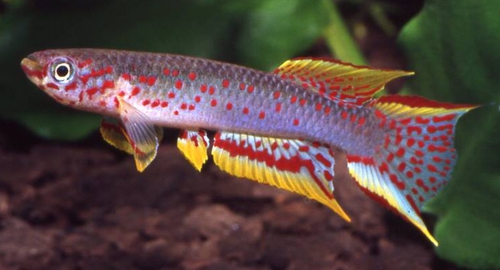Aphyosemion castaneum Myers 1924

A.castaneum HZ 85 / 1. Photo courtesy of Gottfried Marschitz
| Meaning of Name |
Chestnut body colouration. |
||||||||||||||||||||||||||
| First Description |
Myers G.S. 1924 A New Poeciliid fish from the Congo, with remarks on Funduline genera. American Museum Novitates 116, 2-4, fig 1-2. |
||||||||||||||||||||||||||
| Size |
|
||||||||||||||||||||||||||
| Meristics | |||||||||||||||||||||||||||
| Karyotype |
|
||||||||||||||||||||||||||
| Sub-Genus |
Aphyosemion |
||||||||||||||||||||||||||
| Group |
|
||||||||||||||||||||||||||
| Synonyms | |||||||||||||||||||||||||||
|
Populations
|
HZ 85 / 1 -
HZ 85 / 7 -
HZ 85 / 8 -
Kisangani -
Lobaye -
A.sp.OYO - I tentatively place this collection in A.castaneum following Jouke Vdz's comments on DNA studies which places them close to A.castaneum. See bottom of this page for more information on this collection.
|
||||||||||||||||||||||||||
| Type Locality |
Kisangani (then Stanleyville). |
||||||||||||||||||||||||||
| Distribution | Concentrated around the surroundings of Kisangani. Other collections have been made at Salonga Park (by Scheel in 1990), Lompole, Yaka, central Congo basin. Huber in 2005 considered these non Kisangani collections to represent a yet undescribed sp. | ||||||||||||||||||||||||||
| Habitat | |||||||||||||||||||||||||||
| Distinguishing Characteristics | |||||||||||||||||||||||||||
| Colour/Pattern Variability | I
would consider 'Oyo' to be quite variable especially in the caudal fin.
I have seen one photo of this fin solid yellow with black outer margins. http://www.killi-foto.de/aphyosemion.html You need to scroll down this websites page to get to the photo. |
||||||||||||||||||||||||||
| History |
This sp. was for a long time thought to be A.christyi but in a paper by Van der Zee & Huber (2006) the name A.castaneum was shown to be valid. Myers described the sp. from 9 specimens collected
at Stanleyville & Medje in the northern area of the Central Congo
drainage. He considered them sufficiently seperated from related sp.
due to a lack of red spots on sides & red markings in fins 'except
for the anal fin which had an orange line close to the outside edge'.
Scheel in ROTOW 1
p.149 considered that the red pigmentation may have been lost due to
bad preservation. |
||||||||||||||||||||||||||
| Breeding Notes | |||||||||||||||||||||||||||
| Diameter of Egg | |||||||||||||||||||||||||||
| Remarks |
Aphyosemion sp.Oyo
| Collection History |
Collected by Paul de Walgeneer an AKFB member on an expedition to the Congo in 1991. Biotope measurements taken on the 2nd August 1991 were - water temperature 20'C, pH 5.6, DH & KH less than 1', air temperature 25'C. Sympatric sp. included Epiplatys multifasciatus. In Ruud Wildekamp's 'A World of Killies' they are shown as A.aff.lujae (Oyo, eastern Congo). Two collections from the same drainage are known, (Boundji being the other) north of the Zaire River. The known range for A.lujae is south west of there locations over the Zaire River. This paper suggests A.sp.Oyo be placed in castaneum - Van der Zee, J. R., & Sonnenberg, R. (2011). Aphyosemion musafirii (Cyprinodontiformes: Nothobranchiidae), a new species from the Tshopo Province in the Democratic Republic of Congo, with some notes on the Aphyosemion of the Congo Basin. Bonn zoological Bulletin, 60(1), 73-87.. |
| Populations Known |
|
| Specific Articles |
Aphyosemion species Oyo RPC 91/8. T.Lenormand & R.Lamy Chappuis. KCF Killi Revue No.04/99. September 1999. 6 pages including colour photograph. 'A World of Killies' Ruud Wildekamp. See pages 222-224 on A.lujae. Female photo (Gary Bartell's site) - http://www.garysfishroom.us
|
| Captive Status |
May 2000 : Maintained in our tanks. Also in various elegans group projects especially Europe.
|
|
Breeding
Notes
|
Fairly easy to breed in rainwater. Water changes appear to be important. If left without a change for 4 weeks egg production dies off dramatically to the point where no eggs are layed at all. This, despite a heavy growth of floating Ceratopteris. Cause is probably a build up of hormones in the water as Nitrates are used up by the vegetation. It is interesting to note the low pH reading of 5.6 taken in there natural habitat. Perhaps a peat filter or substrate may help if fish refuse to spawn. When collecting eggs, try putting them in a peat extract solution to reduce the spread of fungus. Fry have been observed to grow on in the parents tank. Fry hatched in containers are very small & I find infusoria a valuable food to keep in the fry tanks. I moved a batch of one week old fry to a 3 gallon (14 litre) tank filled with rainwater, with a good growth of algae & they seemed to grow on OK. Breeding report supplied by Ian Fitch 31st October 2004.....Thanks Ian. I age my water in a holding tank for
at least 4 to 5 days before doing water changes and the amount exchanged
is 30% for the 2 and 1/2 gallon tank and 20% for the 10 gallon tank.
These water changes are done weekly and the fish do not lose their appetite
or act shy afterwords. |